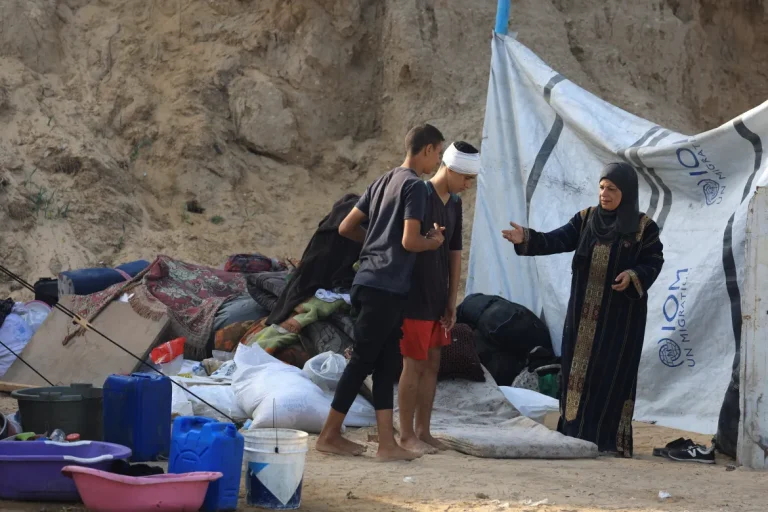Cairo/Gaza: Israeli air and ground forces launched intense assaults across the Gaza Strip overnight and into Sunday, targeting residential areas, flattening homes, and leaving behind scenes of devastation, according to eyewitnesses and civil defense teams on the ground. The escalation has deepened the desperation among Palestinians, many of whom are now placing their hopes in a new peace initiative proposed by former U.S. President Donald Trump, which promises a ceasefire and eventual Israeli withdrawal if accepted by both parties.
The bombardment, which involved warplanes, artillery, and armored vehicles, came just hours after Trump announced that Israel had agreed to a preliminary withdrawal boundary within the Gaza territory. Posting on his social media platform, Truth Social, Trump claimed that once Hamas confirmed its approval, a ceasefire would take immediate effect. However, despite the diplomatic buzz surrounding the proposal, there was little sign on the ground that any truce was imminent.
In fact, the reality in Gaza told a different story. Massive explosions echoed across the densely populated coastal strip through the night, with residents reporting relentless drone activity and strikes that seemed to target both strategic and civilian locations indiscriminately. Entire neighborhoods were left in ruins. In the Sabra and Sheikh Radwan districts of Gaza City, scores of homes were destroyed, with emergency workers sifting through debris in search of survivors and casualties.
The timing of the attacks appeared to coincide with preparations in Cairo, where Egyptian officials are working to convene high-stakes negotiations involving representatives from Hamas, Israel, the United States, and Qatar. The talks are being framed as the most serious diplomatic effort yet to halt the months-long war that has left thousands dead and much of Gaza in ruins.
Trump’s 20-point peace plan, presented as a comprehensive roadmap for ending the conflict, includes key demands: an immediate ceasefire, the release of all hostages held by Hamas, Israel’s withdrawal to designated lines within Gaza, and an eventual process for rebuilding and governance reform in the territory. Hamas surprised many international observers on Friday when it issued a statement expressing tentative acceptance of several central pillars of the plan, particularly those related to a ceasefire, hostages, and Israeli withdrawal.
In Washington, Trump welcomed the response and pressed Israel to reciprocate by halting its offensive. But Prime Minister Benjamin Netanyahu, facing immense political pressure at home from both ends of the spectrum, has not confirmed full acceptance of the terms. His far-right coalition partners have publicly opposed any form of territorial concession or ceasefire, insisting the only acceptable outcome is the complete dismantling of Hamas’s military infrastructure.
Amid this political tug-of-war, civilians in Gaza are trapped in a nightmare of unrelenting violence and vanishing resources. More than 2 million Palestinians remain crammed into a warzone where food, fuel, medicine, and clean water are in critically short supply. Humanitarian agencies warn that if the fighting continues unabated, the territory will face total societal collapse.
In one of the areas hardest hit by recent strikes, residents described scenes of chaos. Families who had already been displaced once or more by earlier fighting were again forced to flee, carrying what little they could salvage. Hospitals are overwhelmed, with medical teams operating around the clock in overcrowded, under-equipped facilities.
Amid the carnage, voices of disbelief and anger emerged. “Where is Trump in all of this?” asked Rami Mohammad-Ali, a 37-year-old father of three, speaking from a makeshift shelter near the Gaza coastline. “He said there would be a ceasefire. He said the bombs would stop. But look around — the bombs haven’t stopped. The killing hasn’t stopped.”
His frustration reflects a broader sense of disillusionment spreading among Palestinians who initially saw a glimmer of hope in Trump’s announcement. Many fear the peace initiative may go the way of previous efforts — mired in technicalities and lost in the political infighting between and within both sides.
One of the most contentious elements of the Trump plan involves the timeline and conditions for hostage exchanges. According to the proposal, all Israeli hostages, both living and deceased, were to be returned within 72 hours of the ceasefire taking effect. In exchange, Israel would release hundreds of Palestinian detainees. Israeli intelligence believes that around 48 hostages remain in Gaza, of whom approximately 20 are believed to be alive.
However, logistical challenges threaten the viability of that timeline. In areas where fierce fighting has occurred, rubble from destroyed buildings makes it nearly impossible to recover the remains of hostages killed in earlier stages of the conflict. Israel has said it would not delay the ceasefire over such logistical issues, but opposition parties within the country have criticized that stance, arguing that bringing every hostage home — dead or alive — must be a precondition to any truce.
Behind the scenes, Egyptian, Qatari, and U.S. officials are working frantically to bridge the remaining gaps. Egyptian intelligence sources report that Hamas remains wary of disarmament clauses in the plan, particularly provisions requiring them to surrender medium and long-range rocket capabilities. Hamas leaders argue that such terms effectively strip them of any future leverage and expose Gaza to future attacks without means of resistance.
For Israel, any withdrawal from Gaza raises deep concerns about security vacuums. Government hardliners argue that without a permanent Israeli security presence in key areas, the territory could once again become a base for armed groups to regroup and rearm. Netanyahu has repeatedly stated that total demilitarization of Gaza must occur before any peace framework is implemented.
In the meantime, ordinary people in Gaza bear the brunt of indecision and deadlock. Entire families live under plastic tarps or inside schools converted into overcrowded shelters. Bakeries no longer function, fuel supplies are nearly exhausted, and potable water is rationed to dangerous lows. The United Nations and Red Crescent have described the situation as approaching the brink of a full-blown humanitarian catastrophe.
Despite the dire conditions, the Trump initiative has stirred conversations among Palestinians about the possibility of a new path forward — however remote it might seem. Political analysts say the very fact that Hamas expressed tentative support for a U.S.-backed framework marks a significant shift, particularly given the movement’s longstanding opposition to Western mediation.
But that shift may come too late for some. In many Gaza neighborhoods, local leaders and community elders say people are growing increasingly skeptical of foreign solutions. Years of conflict, broken promises, and international inaction have eroded faith in outside powers. “We’ve heard of roadmaps, blueprints, peace plans,” said Hanan Nusseibeh, a retired schoolteacher in central Gaza. “They all come and go. Meanwhile, we are still here under fire.”
In Israel, too, public sentiment is deeply divided. While some citizens support the ceasefire plan — primarily the families of hostages — others have taken to the streets to protest what they view as an incomplete mission. For the far-right bloc in Netanyahu’s government, ending the war now would signal weakness and risk emboldening other hostile actors in the region.
Trump’s involvement has also drawn scrutiny. Though no longer in office, his influence on U.S. foreign policy remains potent among certain factions in Israel and the Arab world. His direct engagement in the peace proposal has sparked speculation that he may be seeking to rebuild his credentials on the global stage ahead of a possible political comeback. Whether his plan will succeed where others failed is far from certain.
Meanwhile, the death toll continues to rise. Palestinian health officials report dozens more casualties in the latest wave of airstrikes, while Israeli authorities have confirmed several new injuries from rocket fire launched from Gaza in response. No formal ceasefire has been observed, and without a breakthrough in the Cairo talks, the violence shows no sign of abating.
As delegates begin to arrive in Egypt for what could be make-or-break negotiations, expectations remain fragile. The complexity of the issues, the depth of mistrust, and the scars of ongoing violence make any quick resolution unlikely. Yet, even in the face of overwhelming hardship, some in Gaza continue to hope — not for politics, but for silence, for safety, and for a life where their children can sleep without fear.
For now, that hope rests on words written in distant capitals and the willingness of longtime enemies to find common ground in the ruins.

